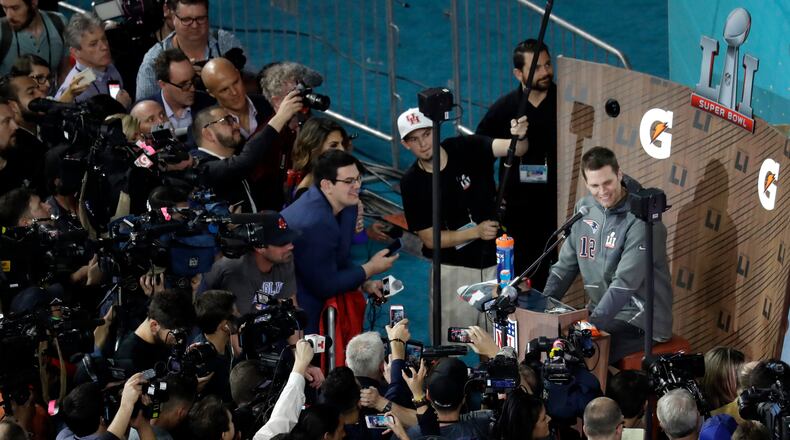This is the week of the low-key Super Bowl, a sentence that couldn’t have been written four decades or even 11 months ago. Once the Super Bowl began to get big, its only goal was to grow bigger and then biggest and then bigger than biggest. The halftime show in January 1971 was the Southeast Missouri State marching band. By 1993, the headliner was Michael Jackson, whose performance began with him standing still for 90 seconds.
Before Super Bowl III, Joe Namath held a media session in swim trunks by the hotel pool. Soon everything would be scripted, scripted, scripted: There’d be a bloated media day on Tuesday, sessions with teams at their respective hotels on Wednesday and Thursday, the commissioner’s address on Friday. A fleet of buses carted us media types from venue to venue, and the strain began to tell. Raiders quarterback Jim Plunkett was asked of his family tree: “Was it dead mother, blind father or blind mother, dead father?”
Investigative journalists such as MTV’s “Downtown” Julie Brown became credentialed media. (She asked Emmitt Smith, “What are you going to wear in the game?”) Not content with merely ruling the airwaves, the NFL began to take over the host city. “The Super Bowl Experience” filled cavernous convention centers, and after 9/11 security became so tight that miles of fencing and concrete were installed. Armed guards patrolled every checkpoint. Before the Patriots met the Rams here in February 2019, downtown Atlanta became Fortress Football.
It will be different in Tampa, host city in our pandemic year. As fate and Tom Brady would have it, one competing teams already lives in the area. The other participant has been instructed not to arrive in Florida until Friday or Saturday. In non-COVID years, both teams hit the ground eight days early, so as to clear the deck for Monday’s “Opening Night at the Super Bowl,” which is what those Tuesday Media Days had become — except that “Opening Night” was akin to asking questions in the world’s loudest and most crowded nightclub. (Yes, the NFL sold tickets for the, ahem, event.)
Credit: AJC
This, however, is the Super Bowl stripped to its bare bones. All interviews will be conducted not by media gaggle but by Zoom. Attendance at the game will be limited to 22,000. Much of the audience will consist of health-care workers who’ve received some version of the vaccine.
“The Super Bowl Experience” will be staged outdoors. Reservations will be required. So will masks.
Will there be a Radio Row? Sort of. Sports Business Daily reports that 35 outlets will attend, one-third the usual number. NBC’s Pro Football Talk, usually one of the hottest stops, asks the key question. Writes Mike Florio: “The interviews will happen via phone and video link. So why go? We’re not.”
As for in-home Super Bowl parties: Should we even be planning those? Chips and dip during a global health crisis?
The NBA and NHL playoffs were held in bubbles — the NBA’s at Disney World, the NHL’s in Canada. The bulk of the MLB playoffs were set in bubble-ish cities. A few fans were allowed at the NLCS and World Series in Arlington, Texas. The College Football Playoff saw its Rose Bowl semifinal uprooted from Pasadena, Calif., and replanted in Arlington. These are strange times for all of us, and they’re especially weird for sports, which live via the rule that there can be no success without excess.
It will be fascinating to see, in a post-COVID world, whether sports return to media policies once considered normal. Will baseball clubhouses open to the media four hours before a game? Will there again be such a thing as an open locker room? Will conference “media days” — the SEC’s stretched to almost a week — involve anything more than a series of Zooms? Is there a need for 400 reporters to be in the same room as an interview subject if technology can do it much cheaper for all concerned?
I don’t know the answers. I doubt anybody does. This time a year ago, nobody would have broached such questions. But our world has been forced to change. When change occurs, often there’s no going back. As someone who has covered the Super Bowl — full disclosure: owning to the media hordes and the logistics, the Super Bowl is among my least favorite things to cover — I wouldn’t mind a future predicated on Zoom.
On the night before another major event — the 1996 Braves-Yankees World Series — was to begin in New York, I was sitting in a Broadway theater waiting for the curtain to go up on “Sunset Boulevard.” A lady from England sat on my right. I told her I was a sportswriter. She asked if could name the soccer player who was sold for the most money. I guessed Gazza, meaning Paul Gascoigne. She guffawed. “Gazza’s a pig!” The answer was Alan Shearer. I felt rather diminished.
Then she said: “Why are you here?” Because, I said, I work for an Atlanta newspaper and the Atlanta Braves are playing for the championship. She cocked an eyebrow: “Couldn’t you just do the commentary from home?” I said no, that’s not how it’s done. We need to be there.
Twenty-five years later, I’m not as sure. The major sports — wherein all teams have their own websites — have lately sought to limit media access. Pandemic restrictions will surely lead to a deeper rethink. Does one outlet need 12 Super Bowl credentials? Must every player be made available before/after every game? Does such availability have to happen in-person?
I don’t know those answers, either. All I know is that those questions are coming.
About the Author
The Latest
Featured



